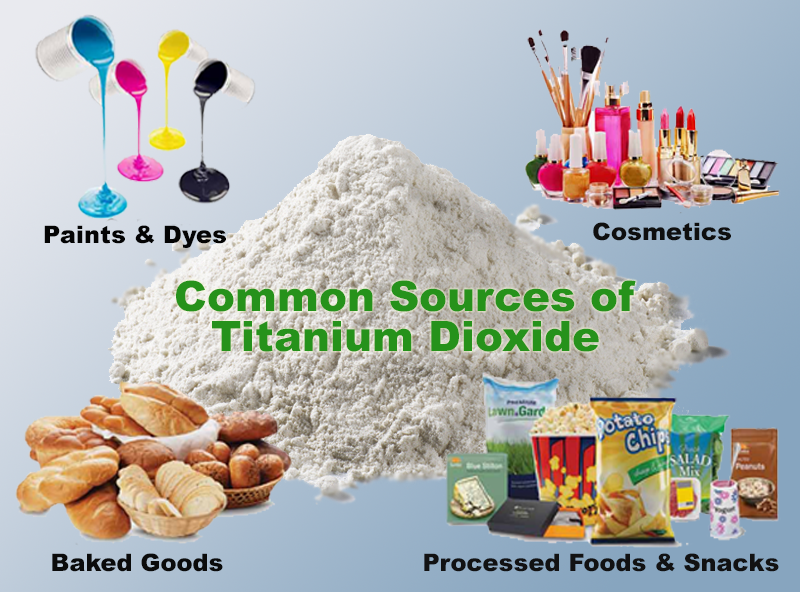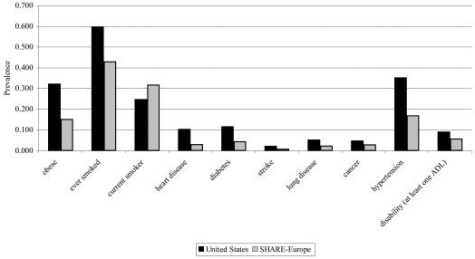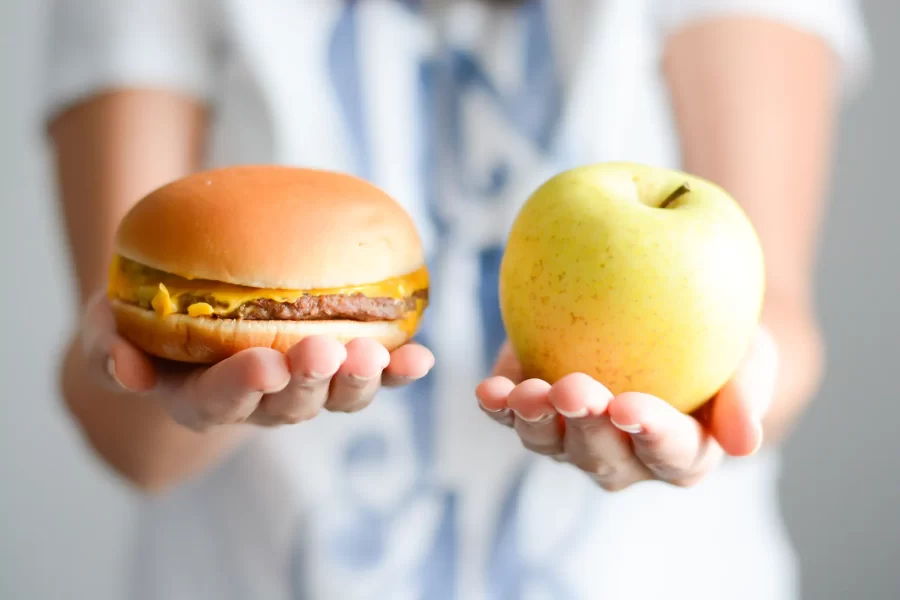The US Chemical Catastrophe: A look into America’s artificial obsession
January 27, 2023
The United States of America is known for overdoing everything. In this case, America is overdoing the chemicals used inside processed foods. Once everything comes down to the real cost, buying a bag of junk food is cheaper than buying vegetables to make a nutritious meal. Due to some economic inequality, on the go lifestyles, and quick meal availability in the United States, many people who buy or have to resort to purchasing these processed junk foods are l ed down a dark path to health problems. Obesity, cardiovascular disease, type two diabetes, and some cancers are linked to these chemicals. In European countries this is not the case. Why set up a system where healthier foods are harder to purchase?
ed down a dark path to health problems. Obesity, cardiovascular disease, type two diabetes, and some cancers are linked to these chemicals. In European countries this is not the case. Why set up a system where healthier foods are harder to purchase?
Food Dyes
The well known food dyes such as Yellow No.5, No.6, and Red No. 40 are found in our everyday snacks and drinks: soft drinks, fruit juices, baked goods, breakfast cereals, processed vegetables, chips, pickles, honey, mustard, gelatin desserts, pudding, ready to use frostings, dessert powders, candy, other foods, gum, cosmetics, medicines. An article featured the Huffington Post, by Jillian Wilson, lists banned chemical additives that are in American foods but not in European foods. In Europe they aren’t necessarily banned, however they come with a warning label that a product contains these dyes. ““While not quite a ban, the EU requires that foods containing certain synthetic food dyes bear a warning label stating ‘may have an adverse effect on activity and attention in children,’” Galligan said. “But no such warning label is required in the U.S.””
Another article about these dangerous dyes shares the true origin of food dyes, by Sarah Kobylewski 1, Michael F Jacobson from pubmed.gov mentions the origin of these dyes. “ Food dyes, synthesized originally from coal tar and now petroleum, have long been controversial because of safety concerns. Many dyes have been banned because of their adverse effects on laboratory animals or inadequate testing” How could they be harmful since th ey are in so many foods and drinks? They also stated that there are health concerns from these dyes. “This review finds that all of the nine currently US-approved dyes raise health concerns of varying degrees. Red 3 causes cancer in animals, and there is evidence that several other dyes also are carcinogenic. Three dyes (Red 40, Yellow 5, and Yellow 6) have been found to be contaminated with benzidine or other carcinogens. At least four dyes (Blue 1, Red 40, Yellow 5, and Yellow 6) cause hypersensitivity reactions. Numerous microbiological and rodent studies of Yellow 5 were positive for genotoxicity.” Next time you take a trip to the grocery store take a double look at the ingredient list and look out for these carcinogenic dyes and try to lower your intake.
ey are in so many foods and drinks? They also stated that there are health concerns from these dyes. “This review finds that all of the nine currently US-approved dyes raise health concerns of varying degrees. Red 3 causes cancer in animals, and there is evidence that several other dyes also are carcinogenic. Three dyes (Red 40, Yellow 5, and Yellow 6) have been found to be contaminated with benzidine or other carcinogens. At least four dyes (Blue 1, Red 40, Yellow 5, and Yellow 6) cause hypersensitivity reactions. Numerous microbiological and rodent studies of Yellow 5 were positive for genotoxicity.” Next time you take a trip to the grocery store take a double look at the ingredient list and look out for these carcinogenic dyes and try to lower your intake.
Brominated Vegetable Oil (BVO)
You may be wondering, why would brominated vegetable oil be in my soda? Well, it is an additive that is used in small amounts to keep the citrus flavoring from floating to the top in some beverages. You can find brominated vegetable oil in these products; Sun Drop, made by the Dr Pepper Snapple Group. Numerous generic citrus sodas also use it, including; “Mountain Lightning”/Walmart sodas, “Clover Valley”/Dollar General sodas, “Orangette” and Stars & Stripes. 
Although it is used in a few beverages, over time it builds up in the body. Studies from mayoclinic.org state that brominated vegetable oil is illegal in the EU (European Union) and Japan, the US uses small amounts while it is still under toxicity study by the FDA. “…there have been reports of people experiencing memory loss and skin and nerve problems after drinking excessive amounts (more than 2 liters a day) of soda containing BVO. While few people are likely to drink such large quantities, concern exists because bromine appears to build up in the body. Although the Food and Drug Administration (FDA) originally categorized BVO as “generally recognized as safe,” the agency later reversed that decision. The FDA continues to allow the use BVO in small amounts while it performs additional toxicology studies.” Why take the risk and ingest a product that has a chemical under toxicology study?
Titanium Dioxide
Titanium Dioxide is an inorganic compound that is used as a white pigment in foods and other products. The products in the United States that you may find that have this chemical in are; milk, coffee creamer, salad dressing, cosmetics, paint, candy and sweets, chocolate, chewing gum, snacks, sauces, and vitamin supplements. This additive is approved by the FDA in the US as “safe for consumption”.
 From thegaurdian.com talk about why this additive is banned in the EU. “EFSA scientists screened nearly 12,000 scientific publications. They were particularly interested in recent research on the “genotoxicity” of titanium dioxide nanoparticles – their ability to damage DNA and lead to cell mutations, potentially causing cancer. In animal studies, nanoparticles have been found to affect microorganisms in the gut, which could trigger diseases.” Why consume a product that will just lead to health problems in the future? Double check your products before you buy them if you are truly concerned about having better overall health.
From thegaurdian.com talk about why this additive is banned in the EU. “EFSA scientists screened nearly 12,000 scientific publications. They were particularly interested in recent research on the “genotoxicity” of titanium dioxide nanoparticles – their ability to damage DNA and lead to cell mutations, potentially causing cancer. In animal studies, nanoparticles have been found to affect microorganisms in the gut, which could trigger diseases.” Why consume a product that will just lead to health problems in the future? Double check your products before you buy them if you are truly concerned about having better overall health.
Cost difference
In the article, Too good to last? Why food in Europe is cheaper, better than in the U.S. by Terry Boyd, he writes about his own shopping experience in Europe which is clearly much cheaper than a swift trip to the grocery store. “I just got back from my local market in Eindhoven with lunch … two avocados and a tomato, everything ripe to the point of perfection. Total cost? 80 euro cents.” Meanwhile the average cost for a single avocado is 1-2 dollars and a tomato is about 0.69 cents. This is double the cost of what prices you’ll find in Europe. Shopping at local farmer’s markets is more eco friendly and cheaper, yet not all locations have accessible local markets.
Article from plutusfoundation.org found studies that state reasons why people in the United States tend to choose the unhealthy and inexpensive alternatives for a meal. “Unhealthy food choices tend to be cheaper. A comprehensive review of 27 studies in 10 countries found that unhealthy food is about $1.50 cheaper per day than healthy food. If you’re feeding a large family, it may cost less to simply buy from the dollar menu or purchase cheap pre-made frozen dinners.” “Unhealthy food is more convenient. It’s easier to pop something in the microwave or make a quick stop at the drive-thru. Many people are juggling multiple jobs and children, which leaves little time for grocery shopping or countless hours prepping and cooking meals each week.” “Unhealthy food tastes better. This isn’t always the case. But many processed foods instantly satisfy cravings for salty or sugary snacks. Think about it. Most people don’t sit around craving healthy carrots when crunchy, salty chips are available.” Over time the cost will take a toll on you financially and physically. Now is the time to make changes to help your health in the future.
Data
 As the US and EU continue to have a growing population the levels of health will change overtime. An article from PubMed Central states that levels of poor health in the EU are less than half of what is in the US. “Both the levels of obesity and growth in obesity are higher in the U.S. than in Europe (based on OECD Health Data, at http://www.ecosante.fr). In 1975, 15% of Americans were obese, while obesity rates in European countries such as France, the Netherlands and Spain were less than 8% as recently as the 1980s. By 2005, the obesity rate in the U.S. was well over 30%, while the European average remains close to 12%.” Over time the data has changed but it stayed at a low percentage, half or a little below half. (graph link here)
As the US and EU continue to have a growing population the levels of health will change overtime. An article from PubMed Central states that levels of poor health in the EU are less than half of what is in the US. “Both the levels of obesity and growth in obesity are higher in the U.S. than in Europe (based on OECD Health Data, at http://www.ecosante.fr). In 1975, 15% of Americans were obese, while obesity rates in European countries such as France, the Netherlands and Spain were less than 8% as recently as the 1980s. By 2005, the obesity rate in the U.S. was well over 30%, while the European average remains close to 12%.” Over time the data has changed but it stayed at a low percentage, half or a little below half. (graph link here)
Watch out for these chemical additives, here is a link to find out more chemicals that are in our US foods. Next time you take a trip to the grocery store take a minute and think, “is my health a priority?”, if so, here is a website that provides ways to affordably start eating healthier so you have a bright future for your health.



